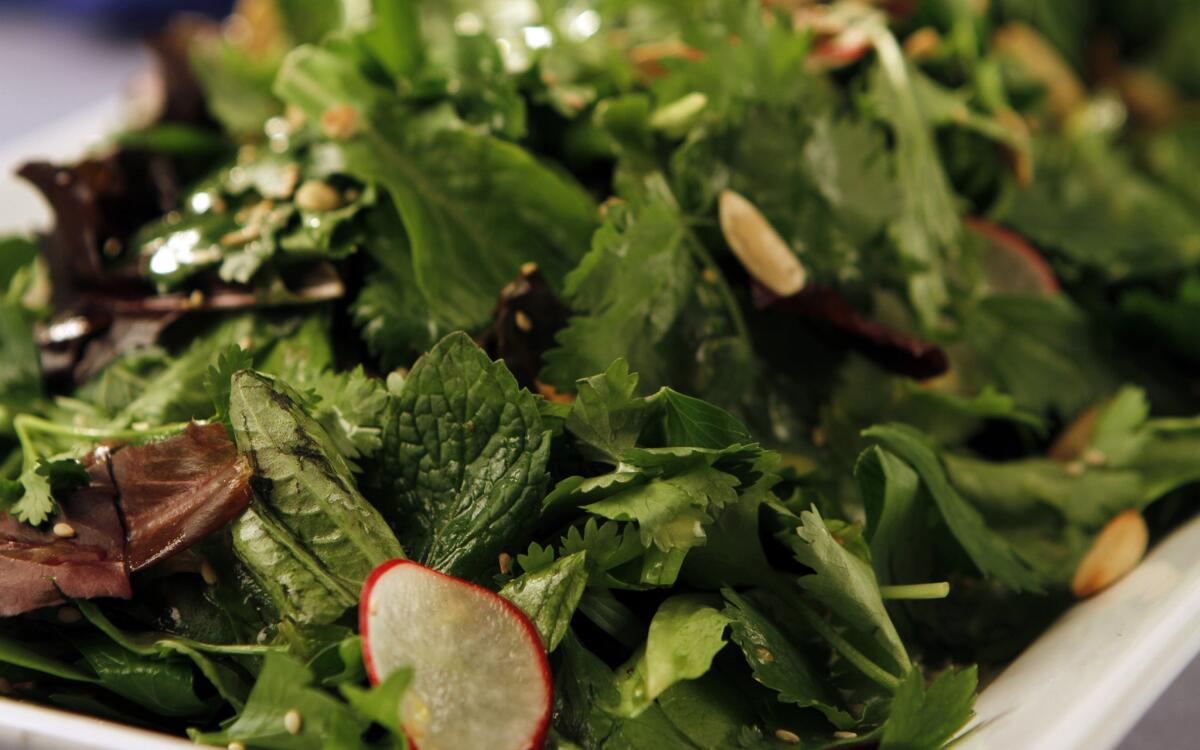Fresh herb salad with seeds

- Share via
There’ll be no potato latkes on my Hanukkah table this year. Yes, I know they’re traditional -- my mother made them every Hanukkah when I was growing up. I’ve also prepared them for my children in years gone by, along with sufganiyot, an Israelified version of the jelly doughnut.
But this year I’m in the mood for something completely different, so I’m taking inspiration for my holiday meal from the Maccabees and combining it with a lesser-known Hanukkah custom of eating dairy foods.
In case you’ve forgotten, Hanukkah commemorates the time around 165 B.C. when the Syrian-Greek king Antiochus Epiphanes captured the ancient land of Israel, plundered and defiled the Holy Temple in Jerusalem, and ordered Jews to give up their religion and assimilate to a Greek way of life.
Some Jews capitulated. Others chose to die rather than submit. But up in the hills not far from Jerusalem, an intrepid band of guerrilla warriors known as the Maccabees fought for religious freedom and succeeded in beating Antiochus’ numerically superior forces.
But when they wanted to rekindle the golden seven-branched Menorah that stood in the Holy Temple, the Maccabees discovered they had only one small cruet of purified olive oil with the high priest’s stamp, enough to last a single day. Yet, a miracle occurred and the oil lamp burned for eight whole days -- just enough time to bring freshly pressed extra-virgin olive oil to the temple in Jerusalem.
Recently, another lesser-known Hanukkah story caught my eye. Based on an ancient book named after the heroine Judith, it is a story that is retold in several versions, one of which claims to have occurred during the Maccabean revolt.
Here’s how it goes: An attractive, noble newly widowed Judith lived in the Judean town of Bethulia, which came under siege by Holofernes, a cruel Syrian-Greek general with a large army. Using her feminine wiles, Judith fed Holofernes her homemade goat cheese and intoxicated him with undiluted wine until he was dead drunk. And then she cut off his head, causing his troops to run, thereby saving her town from destruction.
And though over the centuries in the diaspora, this miracle of the oil was committed to culinary memory and translated into a Hanukkah tradition of oil-fried dishes, the moxie of our heroine Judith was almost forgotten, until a 16th century rabbi named Moses Isserles suggested we honor her memory by adding cheese to our holiday meal. I’m for it.
Now to the menu: Although the Maccabees never left any recipes, as a part-time culinary sleuth, I’m sure that their mobile pantry included native foodstuffs such as bulgur, lentils and barley, harvested in the previous spring and easily stored. I’ll definitely be using those. And I won’t forget the cheese.
First, to honor the latke tradition, I’ll be making mini-latkes from bulgur to fulfill the custom of frying in olive oil. These delicious little latkes, flavored with chopped nuts and onions, can be served as an appetizer or side dish with sweet-and-sour pomegranate sauce or a tahini sauce.
Next, for my lentil and barley main course, I’ll use one of my all-time favorite recipes, and serve it with little bowls of crumbled goat feta cheese and olives on the side.
And of course, I’ll include a salad, symbolic of the wild greens that dot the hills of Jerusalem after the winter rains. I’m pretty sure the Maccabees munched on those as well.
For dessert, I’ll be serving faux sufganiyot based on a buttery choux-pastry dough that includes a blend of whole wheat and white flours to make up more than a dozen bet-you-can’t-eat-just-one pastries, baked rather than fried and topped with a modern-day chocolate-espresso sauce and pistachios.
The Maccabees weren’t lucky enough to have chocolate, but we are.
In a large bowl, toss together the mint, parsley, cilantro and basil, along with the salad leaves and sliced radishes.
Toast the sunflower seeds and sesame seeds separately in a dry frying pan over low heat, stirring frequently until just golden. Mix them together and add three-fourths of the mixture to the salad (save the rest for garnish), and toss to mix.
Combine the olive oil, lemon and orange juice, honey, red wine vinegar, salt and pepper in a screw-top jar and shake until smooth. Taste and adjust the seasonings as desired. This makes about one-third cup dressing.
Just before serving, transfer the salad to a large platter, sprinkle over the dressing, and garnish with the remaining sunflower and sesame seeds. Serve immediately.
Get our Cooking newsletter.
Your roundup of inspiring recipes and kitchen tricks.
You may occasionally receive promotional content from the Los Angeles Times.















